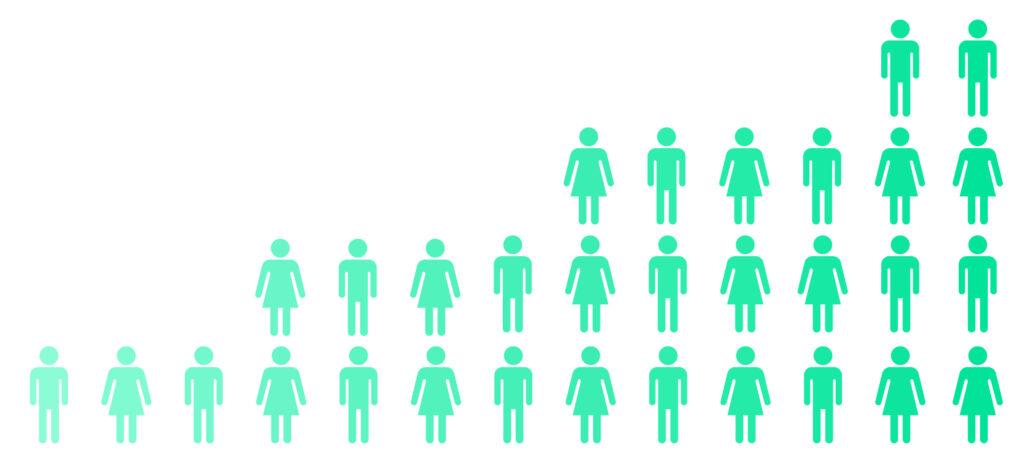Between 2019 and 2020, record-setting amounts of funding were directed into the pharma industry, specifically toward R&D. Thanks to its response to the COVID-19 pandemic, pharma’s reputation has soared – with 40% of the public reporting that they now have a more positive view of the industry – and its coffers now overflow. As a result, R&D divisions are ideally positioned to capitalize on bigger budgets and growing approval ratings to take advantage of emerging pharma R&D trends.
So, what does the future hold for the R&D sector? Here are some of the pharma R&D trends to be on the lookout for.
The role of artificial intelligence in R&D
In recent years, there’s been an embrace of disruptive innovation in pharma. A growing number of companies, large and small, are turning to machine learning and artificial intelligence (AI) to accelerate the drug discovery and drug development pipeline.
Experts believe that AI could optimize drug pipelines, leading to faster clinical trials and greater approval rates. According to the Growth Insight – Role of AI in the Pharmaceutical Industry, Global, 2018-2022 report:
- AI platforms across drug discovery and development workflows could streamline processes, resulting in savings of 3-5%.
- Revenue generated via AI-based solutions is projected to rise at a CAGR of 21.94%, reaching $2.199 bn by 2022.
- Between 2013–2018 there was $7.2 bn in investment across 300+ deals.
- The US is the market leader, accounting for 78.2% of revenue share.
What role will AI play?
It all comes down to data. The massive increase in data digitization within the pharmaceutical sector has, in many ways, necessitated sophisticated artificial intelligence. Its ability to collect, collate, and analyze colossal troves of data make it an invaluable tool throughout the lifecycle of pharmaceutical products. Therefore, it will likely play a role in many R&D activities, including:
- Drug discovery
- Drug screening
- Prediction of physicochemical properties
- Prediction of bioactivity
- Prediction of toxicity
- Designing drug molecules
- Prediction of target protein structure
- Prediction of drug-protein interactions
- Advancing pharmaceutical product development
- Advancing pharmaceutical manufacturing
- Supporting quality control and quality assurance
- Optimizing clinical trial design
- Improving product management
- Market prediction and analysis
R&D spending is set to increase
The role of research and development in the pharmaceutical industry has always been important. Traditionally, the factors that have influenced R&D spending are threefold: 1) the expected revenue from new drugs and products 2) the expected cost of developing the drug 3) domestic and international policies that may influence the supply of and demand for the drug.
In the pharmaceutical industry, R&D spending is typically directed to one of several activities. Currently, the chief vectors are:
- Invention – Research and discovery of new drugs and products.
- Development – The clinical testing and submission of drug applications to the FDA.
- Innovation – Enhancing existing drugs, including new dosages and delivery mechanisms.
- Product differentiation – The clinical testing of a new drug against a competitor’s product.
- Safety monitoring – Clinical trials and longitudinal studies to identify side effects.
According to the Congressional Budget Office report, between 2000-2020, the average R&D intensity – R&D spending as a share of net revenues – for the pharmaceutical industry outpaced all other major publicly traded companies.
With each passing year, there’s been a sustained increase in R&D spending. Although, as the CBO notes, that’s not necessarily reflective of the number of new drugs released. By 2019, the pharmaceutical industry spent $83 billion on R&D – a 10x increase in spending from 1980. Within the industry, the areas where U.S retail drug spending has increased the most are oncologic, diabetes, and autoimmune diseases.
At the current rate, global spending on pharma R&D in 2022 will reach $202 billion.
Small companies will continue to pioneer innovation
While the general public seems to think that Big Pharma is at the forefront of pharmaceutical innovation, in recent years, it’s actually been smaller companies and emerging startups that are shaking up the market and pushing for innovation within the industry.
Admittedly, the pharma giants – the Johnson and Johnsons, Pfizers, and Astra Zenicas of the world – were the driving forces behind the COVID vaccine, but these days, that seems to be the exception and not the rule.
For years, key opinion leaders within the space have warned that the current biotech and pharma model was bloated and unworkable. Smaller companies, they suggested, were more nimble, more willing to take on risks or challenge the status quos.
The result? Faster, more cost-effective pipelines—and we’ve seen that trend play out. According to Pharma Voice:
- Small pharma companies are responsible for 63% of all new prescription drug approvals over the last five years.
- In 2009, small pharma was responsible for 31% of all new molecular entities (NMEs). By 2018, that figure grew to 64% of all NME approvals.
- Emerging companies account for more than 70% of the total R&D pipeline, a 53% increase from 2003.
- In 2010 there was $1.1 billion VC funding, with 152 deal counts. By 2019, that increased to $10.4 billion and 556 deals.
These figures don’t signal a downturn for Big Pharma. However, they do indicate that the R&D model is moving toward a synergistic relationship between the two ecosystems. Per the CBO, “Although total R&D spending by all drug companies has trended upward, small and large firms generally focus on different R&D activities. Small companies not in PhRMA devote a greater share of their research to developing and testing new drugs, many of which are ultimately sold to larger firms.”
Going forward, big pharma companies will continue to channel more funds toward smaller grassroots ventures to leverage their pharmaceutical innovation. Whether that means acquiring them, investing in their pipeline, or purchasing the rights to their product, it’s a good omen for the industry as a whole.
Increased patient involvement
The entire medical sector has experienced a movement toward a value-based care system, wherein the patient voice is incorporated throughout the decision-making process. Now, there’s a growing clamor from the general public to be heard and included in the conversations that impact their health.
Savvy pharma companies are recognizing this movement and realizing that patients’ voices are a resource that can and should be leveraged. So, they’re installing measures to make the pharma R&D process more patient-centric to improve patient satisfaction and patient outcomes.
According to Deloitte, examples of patient-centricity in action include:
- Conducting studies to figure out patient preferences directly from the patient
- Studying patients at different points along the treatment journey
- Partnering with advocacy groups to build trust and gain insights
- Increasing transparency throughout the process of therapy development and beyond
- Using digital solutions as a supplement to hearing directly from the patient
- Focusing holistically on the drivers of health that impact patients and communities
For life science companies looking to advance patient-centric approaches, Deloitte recommends that you start by identifying and operationalizing strategic objectives around the patient perspective. From there, you can track your progress against KPIs and ROIs goals, using digital and pharma R&D analytics to engage patients and improve the overall experience.
The emergence of in silico trials
Historically, animal and human testing was a necessary albeit uncomfortable facet of clinical trials. In vivo and in vitro experiments were critical measures to ensure the efficacy and safety of both new and existing drugs. But once more, this is a space where digitization may change the life science industry for the better.
Today, there’s been significant progress within silico tests – experiments conducted via computer simulation to evaluate a specific intervention. Researchers can now develop virtual patient populations using clinical databases that reflect critical demographic factors like race, age, sex, blood type, and physiology. Then, simulations can model the impact of potential drugs or interventions on those populations.
In 2021 an in silico trial of intracranial flow diverters on treating brain aneurysms was able to replicate and even expand the insights from conventional trials. According to the conclusion: “We demonstrated that similar quantitative conclusions can be made about the performance of FDs in both in-silico trials and clinical trials. This was achieved in the FD-PASS by showing that the predicted postoperative occlusion likelihood was similar to results observed in the reference clinical trials.”
Aside from the fact that this practice will now reduce the use of humans and animals in testing, the digitalization of clinical trials will provide myriad other benefits, including:
- The capability to replicate clinical trials findings but at a fraction of the time and cost
- The ability to adapt computational models to research new scientific findings or variations on the same trial
- The rigorous analysis makes it possible to optimize drug and device design, thus reducing treatment risks
- Digital clinical trials make it possible to conduct trials that would be difficult or impossible using humans or animals
Furthering progress and innovation within R&D
The future for R&D within the life science sector looks bright. Increased optimism has supercharged funding, which only further incentivizes new players. Going into 2022, the digitalization of the pharma industry will continue apace, shaking up the market and changing how R&D is conducted.
After identifying the industry-wide problem known as the insight gap, Within3 created its insights management technology – a solution that considers disparate, slow, and fragmented insight-gathering processes as a single process that can be solved on a single platform.
By pioneering a platform that champions smarter insights management for every stage of your process – virtual advisory boards, clinical trial development and operations, publication development, or other applications – our platform makes it easier to engage internal and external stakeholders throughout the entirety of your pipeline.
Request a needs assessment and demo today.






